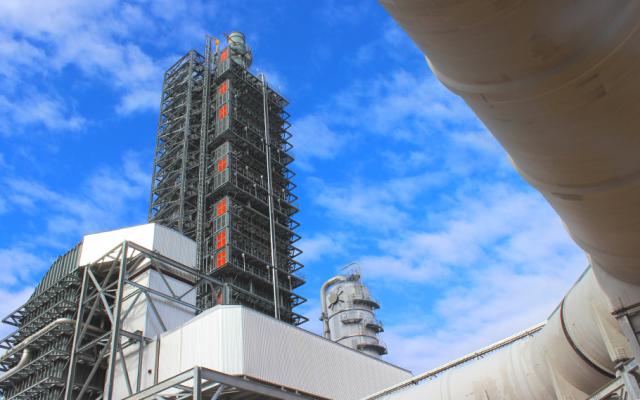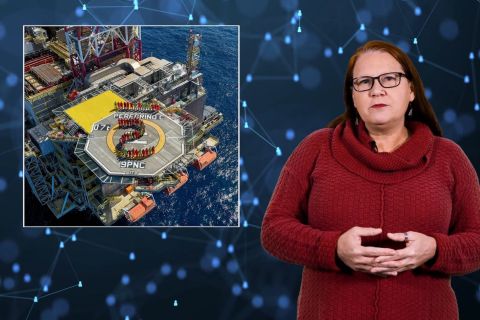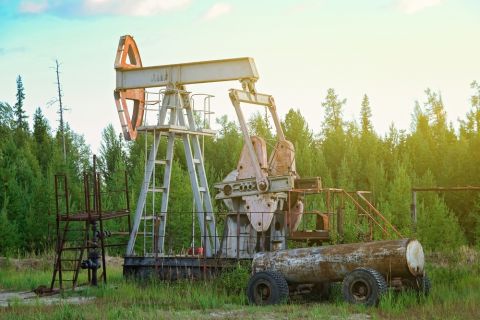
Ductwork takes flue gas from the coal plant to the carbon caption facility where the CO2 is removed from the flue gas. (Source: Business Wire)
NRG Energy, JX Nippon and partners’ $1 billion unit to capture CO2 from a power plant and transport it via pipeline for EOR at the West Ranch oil field has been completed, the companies said Jan. 10.
So far, more than 100,000 tons of CO2 has been captured from NRG’s WA Parish plant in Fort Bend County, Texas, and delivered via a 90-mile pipeline to the Hilcorp Energy Co.-operated West Ranch oil field as part of Petra Nova, as the project—deemed the largest post-combustion carbon capture system (CCS)—is called.
The CO2 is expected to grow oil production at the field, in which NRG and JX Nippon also hold interests, from 300 barrels per day (bbl/d) to up to 15,000 bbl/d over the next few years, an increase of 5x.
“To date we have drilled nearly 100 new wells in the West Ranch Field and have implemented a robust CO2 and groundwater monitoring program,” Hilcorp CEO Jeffery D. Hildebrand said in a statement. “We are excited about this project and expect to see a meaningful increase in oil production at West Ranch in the near future.”
The system captured more than 90% of the CO2 from a stream of flue gas from the power plant during performance testing in December 2016, NRG said in a news release. When operated at this level, the CCS is capable of capturing more than 5,000 tons of CO2 daily.
Key to the accomplishment is technology co-created by Mitsubishi Heavy Industries and Kansai Electric Power Co.
As explained during the September 2014 groundbreaking event for Petra Nova, flue gas from the power plant is run through a vessel where a solvent captures the CO2. The chemical has a socket that fits CO2, enabling the two to bind, be pumped into a vessel and heated to release the CO2, which is then segregated into a pure CO2 stream.
From here, the CO2 flows through the pipeline to the oil field. Once injected, the CO2 dissolves into the oil, lowering the oil’s viscosity enough so that as water sweeps though the formation, oil is pushed up and produced. From this point, the water, oil and CO2 are separated in a processing facility. The CO2 is then compressed and reinjected into the reservoir, and the process starts again. The process is called KM-CDR.
The financial success of the $1 billion project, which received up to $190 million in federal grants from the U.S. Department of Energy, rests in part on oil prices, which have fallen far from roughly $93.32, which a barrel of West Texas Intermediate crude was fetching Sept. 5, 2014.
But the environmental benefits are expected to help push NRG closer to its goal of reducing its carbon emissions by 50% by 2030.
NRG CEO Mauricio Gutierrez called Petra Nova “another major step in NRG’s effort to reduce our carbon emissions and create a more sustainable energy future, and we are proud that this accomplishment was achieved on-budget and on-schedule in a competitive energy environment.”
Shunsaku Miyake, president and CEO of JX Nippon Oil & Gas Exploration Corp., added “the project will contribute to significantly increasing incremental crude oil production from legacy oil fields and also will be a major step forward in helping to decrease CO2 emissions globally.”
Velda Addison can be reached at vaddison@hartenergy.com.
Recommended Reading
Tech Trends: SLB's Autonomous Tech Used for Drilling Operations
2024-02-06 - SLB says autonomous drilling operations increased ROP at a deepwater field offshore Brazil by 60% over the course of a five-well program.
E&P Highlights: March 4, 2024
2024-03-04 - Here’s a roundup of the latest E&P headlines, including a reserves update and new contract awards.
NAPE: Turning Orphan Wells From a Hot Mess Into a Hot Opportunity
2024-02-09 - Certain orphaned wells across the U.S. could be plugged to earn carbon credits.
Rystad: More Deepwater Wells to be Drilled in 2024
2024-02-29 - Upstream majors dive into deeper and frontier waters while exploration budgets for 2024 remain flat.
E&P Highlights: April 1, 2024
2024-04-01 - Here’s a roundup of the latest E&P headlines, including new contract awards.






